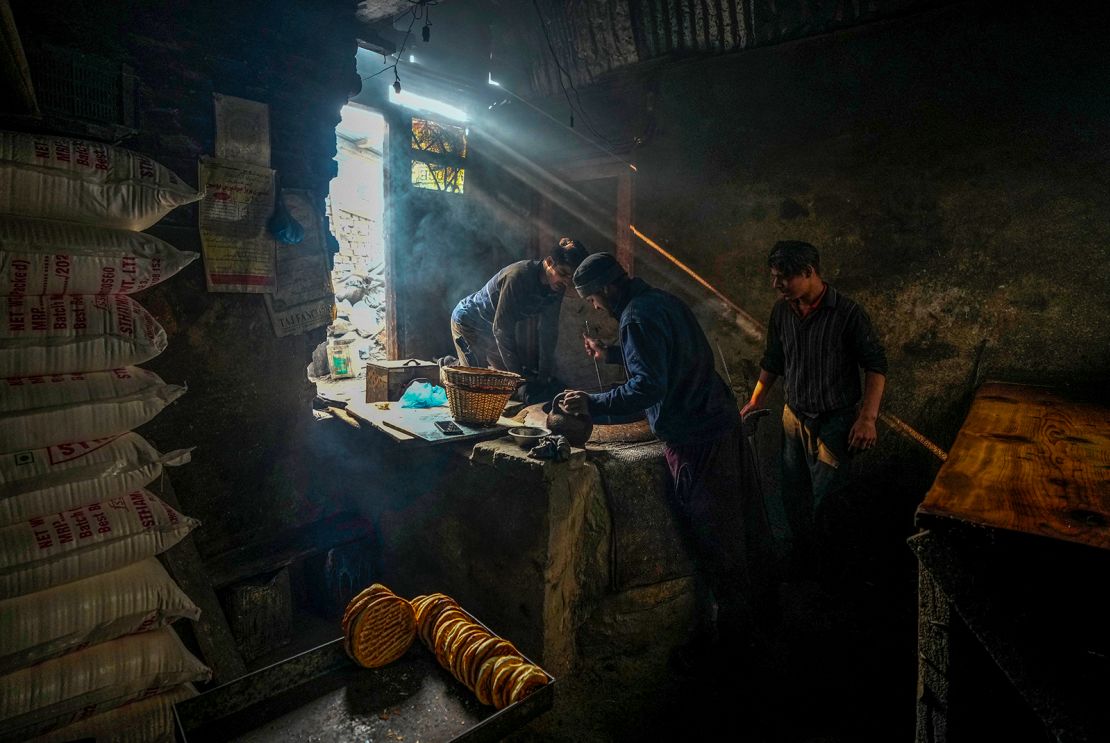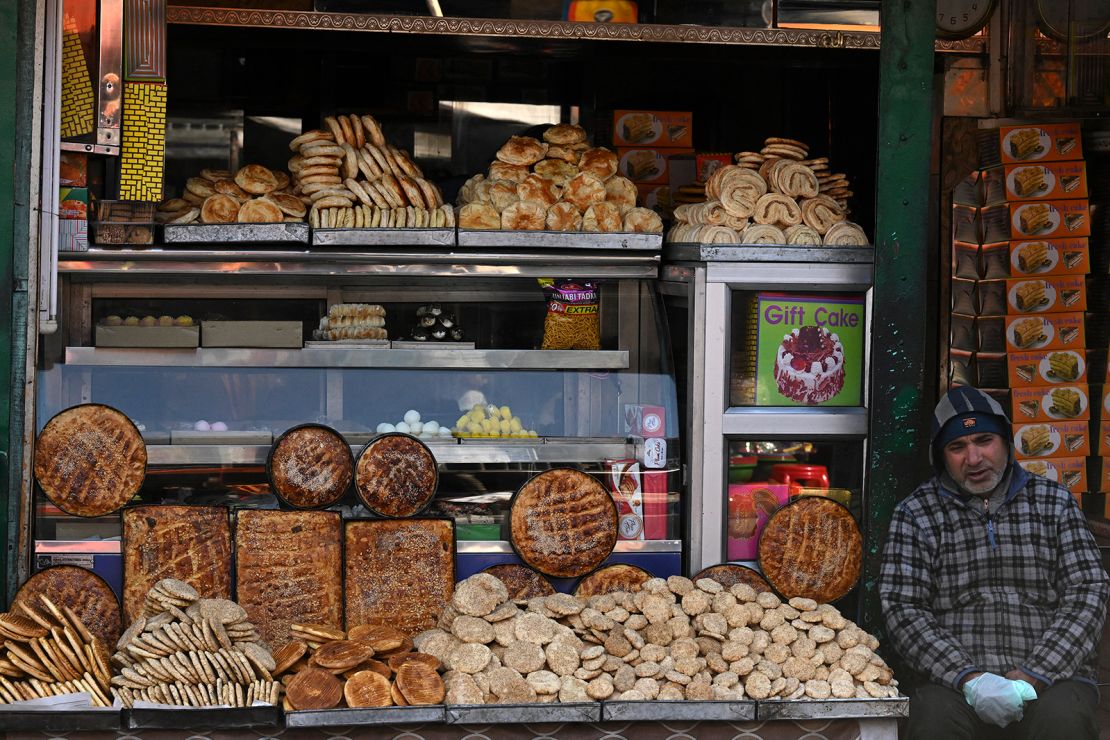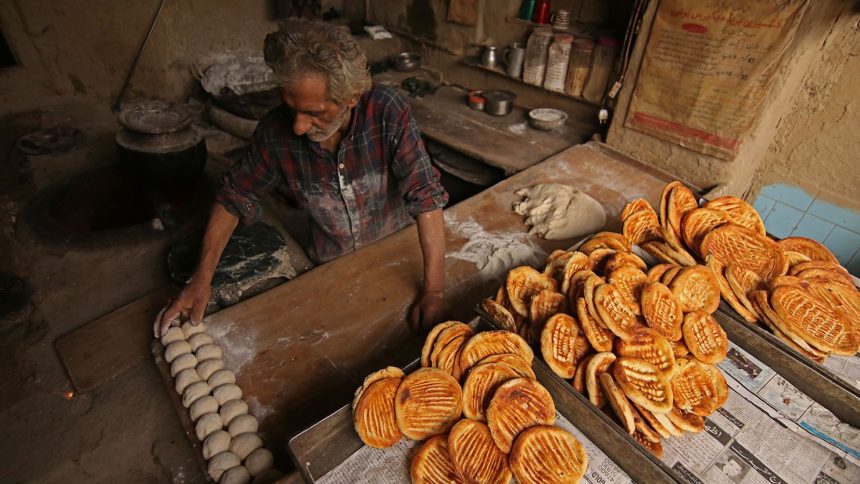Srinagar, India
CNN
—
In Indian-administered Kashmir, long before the morning call to prayer reverberates across neighborhoods, the city of Srinagar’s kandurs, or bakers, have fired up their tandoor ovens.
Located in the snowy Himalayas, at the northern tip of India, this disputed region between India and Pakistan is a paradise of snowy glaciers, ice-blue lakes, fir-lined mountains, and gushing, stormy rivers. So famed is its beauty that Mogul Emperor Jehangir once remarked, “If there is a heaven on earth, it’s here, it’s here, it’s here.”
Kashmir’s rich history includes the legacy of Buddhist pilgrims, Islamic rulers, Sikh dynasts and Central Asian Silk Road traders, who brought their arts, crafts and rituals to this treasured land that remains one of the world’s most militarized regions, marred with decades of conflict and violence.
But beyond the troubled state’s borders, few talk of the artisans who work with flour, water and ghee (clarified butter) to give Kashmiris their daily bread.

The region’s rich bread culture is a patchwork of the legacy of the Silk Road, an ancient trade route that connected Europe, the Middle East and Asia along the way. While rice is the staple that’s cooked in households across Kashmir, bread is what drives the local community and economy. Local bakeries churn out roughly 10 kinds of bread a day, each with its own peculiar ritual and time of day to be consumed.
With so much traditional knowledge guarded and passed down through generations, Kashmir’s bread culture could qualify for a UNESCO intangible heritage listing and possibly rival France’s boulangerie tradition. So why does no one talk about this culinary legacy?
Mehvish Altaf Rather, a Kashmir-based documentary filmmaker, tried to change that when she made her film “Kandurwan: Baking History,” in 2019. The piece offers a peep into life in the valley, of which the kandurwan (bakery) forms an integral part.
“I wanted to capture the daily life of Kashmiris and talk about the one thing that everyone can identify with, a love for food,” she tells CNN.
Bothered by the singular narrative around bloodshed and politics emerging from Kashmir, Mehvish turned to another aspect of local culture to tell a larger story.
“The identity of Kashmiris is constantly threatened, so bread is part of a culture that we hold onto very dearly,” she says, explaining how the kandurwan is a place of congregation and culture in Kashmiri society.
Kandurs, the traditional bakers of Kashmir, use clay tandoor ovens to prepare various breads. This baking tradition is similar to those found throughout Central Asia. The term “tandoor” comes from the Persian word “tanur,” meaning oven. Despite its ancient origins, the technique of using the clay oven for bread making has remained largely unchanged, deeply ingrained in Kashmiri culture.
On their way back from the mosque, locals pick up freshly made, crisp-on-the-outside, pillowy-on-the-inside, circular girdas and crunchy, thin lavasas for the entire family. As they wait for the shop boys to wrap up their warm breads in yesterday’s newspaper, locals swap daily news, essential information and, more often than not, gossip.
“These kandurs are experts in extracting information out of you! The conversation will start with an innocent ‘Did you hear the news?’ and after some raised eyebrows, it will lead to the customer divulging the juiciest bits of news,” says food writer and author Marryam H. Reshii, who lives between Srinagar and New Delhi.
“Sometimes when my husband takes more than 30 minutes for what is actually a five-minute job of picking up the morning bread, I know he’s catching up on all the local news at the kandurwan.”
Brought up Catholic in Goa, an erstwhile Portuguese colony that is now India’s sunshine state, Reshii was fascinated by her Kashmiri husband’s bread traditions. They differed vastly from those in Goa, where Portugal’s bread-making techniques blended with local ingredients and tastes.
“India has a very diverse bread culture, but Kashmir’s is wholly unique,” she explains.
For starters, most breads in Kashmir are cooked in an underground tandoor at a kandurwan, while across India, they’re cooked on a pan or baked in an oven.
Besides girda and lavasa, Kashmir’s bread pantheon includes the croissant-like katlam, kulcha, the bagel-esque, sesame-seed dusted tschowor, the festive sheermal, the flaky bakarkhani and roth, to name a few.
“There’s a very complex ritual around what one should eat with which bread and at what time of the day. But it’s not documented and no one tells you. You simply have to learn by observation,” says Reshii.
In the morning, girda and lavasa are consumed with noon chai, a savory tea made with milk, butter and salt. The breads are also paired with eggs or butter and jam. In the afternoon, one might eat a tschowor, that’s often introduced to outsiders as an equivalent to the bagel.
Then there’s bakarkhani, served on special occasions. The layered bread is often large, with a diameter that can extend up to 36 inches. It goes well with mutton dishes like lamb rogan josh. Roth, which is sweet, spongy and sometimes studded with dry fruits, is a celebratory food, and a favorite across Hindu and Muslim families in the region.
“Every Kashmiri has their favorite bread and is partial to their family kandur,”explains Jasleen Marwah, the chef-founder of Folk, a regional Indian cuisine cafe in Mumbai. Her father hailed from Kashmir so for her, summertime equals Kashmir, and Kashmir equals a warm, pillowy girda.
”Our family’s morning order of girda was seven. I’d always buy eight so that I could eat a freshly baked one on my way home from the kandurwan,” says Marwah. While she enjoyed eating the breads of Kashmir as a child, it was only when she became a professional cook that she realized the sheer weight and heft this culinary legacy holds.
“All these breads are as technique-driven as a croissant, bagel or sourdough. For many of them, the process is very similar to making a sourdough,” she says.
Marwah believes that since much of this tradition is passed down orally and has not been officially documented, few outside the region can truly appreciate it.
Now, she and a host of other chefs across India are hoping to change that. On Marwah’s menu at Folk, she offers a few Kashmiri breads adjusted in recipe and size for an office-going lunch crowd in Mumbai.

Prateek Sadhu, one of India’s most celebrated chefs, grew up in Kashmir but was forced to leave his home in the early 1990s when violence escalated.
“As immigrants, the only thing we could carry with us was food and language,” he explains, as he presents a 14-course meal at his fine dining restaurant Naar, located in the foothills of the Himalayas in India’s Himachal Pradesh.
One of the courses he offers is the bakarkhani that he serves with five condiments from the Himalayan belt along with smoked pork.
Over in Mumbai, at Masque, (#23 on Asia’s 50 Best Restaurants List), chef Varun Totlani has served a variety of breads from Kashmir, including tschowor, katlam and tzir tzcot, which is similar to a rice pancake. On the latest menu, he offers a sheermal-inspired bread and a lamb floss kebab with a gravy of yogurt and cardamom.
Over at The Bombay Canteen, in Mumbai’s business neighborhood of Lower Parel, Hussain Shahzad has served girda with a Kashmiri-style gucchi or morel preparation.
“While our tradition needs to be preserved, it also needs to be interpreted for today’s diner. That’s the only way it will evolve,” says Vanika Chaudhury, the chef-founder of the recently-shuttered and critically acclaimed Noon in Mumbai.
Vanika grew up in Kashmir and left home to pursue a career. When she returned years later, to learn more about Kashmir’s bread culture from her neighborhood baker, she was promptly told off. “I told him that I was in town for a week and that I’d come every morning to watch and observe. He scoffed and told me that it would take me a minimum of three years to understand them,” says Chaudhury.
At a collaboration with Silo, London, chef Douglas McMaster and Chaudhury curated a one-of-its-kind 10-course menu that featured an instant hit: bakarkhani layered with shavings of a dried local lemon called gondhoraj. It was served with a koji butter.
“Bread is really sacred in Kashmir and that relationship that a family has with their local kandurwan is really special. Having recently moved back home, she is now spending her time researching local food rituals for an upcoming cookbook. “If we don’t shout from the rooftops about our own food culture, who will?”







